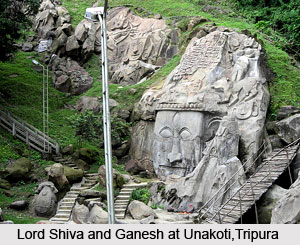 History of Tripura is a long drawn story which dates back to the time of one of the famous epic in India, Mahabharata. At the very helm of the Kingdom of Tripura, it was encompassed the whole of Eastern Bengal that is stretching from the Bay of Bengal in the South to the Brahmaputra River in the North and West and Burma in the East.
History of Tripura is a long drawn story which dates back to the time of one of the famous epic in India, Mahabharata. At the very helm of the Kingdom of Tripura, it was encompassed the whole of Eastern Bengal that is stretching from the Bay of Bengal in the South to the Brahmaputra River in the North and West and Burma in the East.
Early History of Tripura
The earliest trace of the history of Tripura can be found in the inscriptions of Ashokan Pillar. The history of Tripura points out that around the 7th Century the Tripuri Kings with the title of `pha` which means father, ruled from the Kailashahar region in North Tripura. The history of Tripura is extremely intriguing and there are a number of controversies regarding Tripura- origin of name .There are a number of historians who debate the origin of the name of Tripura and they put forward a number of theories regarding Tripura- origin of name. Rajmala is probably the only written regional chronicle on the region which sheds light on its history. Rajmala, which is the court chronicle of Tripura, points out that the region had an ancient king named Tripur. It is believed according to Indian mythology, Tripur was a tyrant king belonged from Demon family and many historians argue that it was after him that the region was named.
The history of Tripura points out at its past of royal dynasty. The kings of Tripura like Tipra Kingdom, Pratap Manikya II, Dhanya Manikya, Dhwaj Manikya were an integral part of this royal past. The 3000 years long history of Tripura reveals the long dynamic history of the Tripura Kings. Long back in the 7th Century, the Tripura Kings adopted the title of `pha` and ruled the region from the then capital city of Kailashahar in North Tripura. In the later phase that in the 14th Century AD that the most important dynasty of Tripura ascended the throne.
 Medieval History of Tripura
Medieval History of Tripura
The history of Tripura appears in the chronicles of Rajmala, the royal chronicle of the Tripura Manikya dynasty. Manikya dynasty originated in the 1280 A.D when the King of Tripura Ratna Fa assumed the title of Manikya, Indo- Mongolian in origin, the Tripura Manikya dynasty ruled over the region for hundreds of years. Under their rule a number of military victories earned Tripura the suzerainty over Myanmar, Bengal and Assam. The prosperity of the Manikya dynasty was all rounds and their fame and power was even acknowledged by the Mughal Emperors in India who were their contemporaries in North and North east of India.
In the 14th Century AD, Tripura witnessed a change with the sifting of the capital from Kailashahar to Udaipur. It was around the same time that the Tripura kings adopted the title of Manikya. The Manikya dynasty had an Indo- Mongolian origin ruled Tripura for around 3000 years. This was probably the most glorious episode of the history of Tripura and the dominance of the Manikyas was also acknowledged by the Mughals who were the original rulers of Tripura.
The 17th Century is a major watershed in the history of Tripura when the administration of the region passed on the hands of the Mughals with some restrained powers of the Manikyas. With the coming of the colonial era the Britishers extended their control over Tripura but granted some independence to the Manikya kings.
Modern History of Tripura
The dictatorship in Tripura ended in the year 1947, the year when India gained independence. From that time, the monarchy in the state was completely terminated. Bir Bikram Kishore Manikya was the last ruling Manikya king of Tripura. After his death the Tripura was acceded to Indian Government. In the year 1949, Tripura became a Union Territory of India and in the year 1972 when Tripura was made a constituent state of the Indian Nation.






